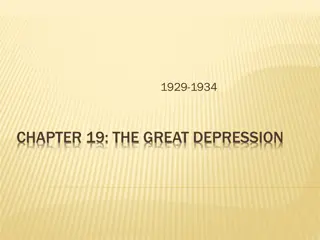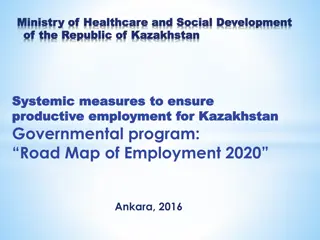The Great Depression and the New Deal (1928-1941): Economic Hardship and Unemployment Impact on Americans
The Great Depression hit America hard, causing widespread unemployment, homelessness, and poverty in both urban and rural areas. This period of extreme economic hardship tested the resilience of the American people, leading to significant suffering and challenges for families, farmers, and minority groups. The images and lessons highlighted in this content illustrate the devastating effects of the Great Depression on various aspects of American society, ultimately shaping the country's path towards recovery and prosperity under the New Deal policies.
Download Presentation

Please find below an Image/Link to download the presentation.
The content on the website is provided AS IS for your information and personal use only. It may not be sold, licensed, or shared on other websites without obtaining consent from the author.If you encounter any issues during the download, it is possible that the publisher has removed the file from their server.
You are allowed to download the files provided on this website for personal or commercial use, subject to the condition that they are used lawfully. All files are the property of their respective owners.
The content on the website is provided AS IS for your information and personal use only. It may not be sold, licensed, or shared on other websites without obtaining consent from the author.
E N D
Presentation Transcript
The Great Depression and the New Deal (1928-1941) Lesson 2 Americans Suffer
The Great Depression and the New Deal (1928-1941) Lesson 2 Americans Suffer Learning Objectives Examine the spread of unemployment in America s cities. Analyze the effects of the Great Depression on farmers. Analyze the impact of human and geographical factors that created the Dust Bowl. Describe how the Great Depression affected family life and the lives of African Americans and Mexican Americans.
The Great Depression and the New Deal (1928-1941) Lesson 2 Americans Suffer Key Terms bread line Hoovervilles tenant farmers Dust Bowl Okies repatriation
Economic Hardship Shakes the Cities The stock market crash signaled the end of boom times and the beginning of hard times. As investors mourned their losses, Americans watched the economy stagger into the Great Depression. In the cities and on the farms, desperate poverty gripped the nation. Even after prosperity returned, those who lived through the crisis would remember the pain and worries of the depression. Tested by extreme hardship, this generation of Americans forged a character and will strong enough to overcome economic ruin and restore prosperity.
Economic Hardship Shakes the Cities Unemployment Leaves Families Struggling Poverty Becomes a Reality for Many The Challenges of Homelessness
Economic Hardship Shakes the Cities Unemployed men gathered outside a busy New York City unemployment office during the 1930s. New York police officers stood guard. Draw Conclusions Why do you think this unemployment office required guarding?
Economic Hardship Shakes the Cities Analyze Graphs How many millions of people lost their jobs between 1928 and 1933? During which years did unemployment increase the most?
Rural America Struggles with Poverty In cities and towns across the nation, Americans faced a terrible plight. The numbers of the unemployed, homeless, and hopeless increased like a casualty list in some great war. In rural America, people fared no better. In fact, sometimes their condition was even worse. Farmers had been suffering even before the Great Depression. Falling commodity prices and accumulating debt had made it a struggle for farmers to keep their heads above water. Many failed to stay afloat and sank so deep that they lost their farms.
Rural America Struggles with Poverty Crop Prices Fall Losing the Family Farm The Dust Bowl Moving Wherever Work Can Be Found
Rural America Struggles with Poverty Draw Conclusions Why did commodity prices fall after 1919, even though the Great Depression was years away?
Rural America Struggles with Poverty Dairy farmers poured out their milk as part of a 1932 protest. Infer What can you infer about the price farmers received for milk in 1932?
Rural America Struggles with Poverty Analyze Maps Which two states appear to have been hardest hit by erosion? What is unusual about California's location compared to other destinations?
Rural America Struggles with Poverty Combined with the severe drought, how did the planting of wheat lead to the loss of topsoil and the dust storms?
Hard Times Hit Most Americans One of the ironies of the depression was the word itself. In the nineteenth and early twentieth centuries, an economic slump was called a panic or a crisis. President Hoover used the word depression to describe the state of affairs because he thought it sounded less severe than the other terms. But before long, Hoover s depression gave way to the Depression and then the Great Depression. The term described not only a state of mind, but also an economic reality. It showed a despondent America, filled with people overwhelmed by seemingly inescapable poverty. Not only did the depression make victims of the men and women who lost jobs, it also was an economic and emotional crisis that profoundly affected U.S. society.
Hard Times Hit Most Americans Families Suffer During the Depression Poor Minorities Suffer Disproportionately
Hard Times Hit Most Americans Wealthy individuals often had to accept menial jobs to make a living. After losing his wealth in the stock market crash, former millionaire Fred Bell sold apples on a street corner.
Quiz: Economic Hardship Shakes the Cities What does it mean to say that factory workers sometimes went from unemployed to unemployable ? A. They started off wanting to work but changed their minds. B. They took on a ragged appearance that kept employers from hiring them. C. They physically broke down and were no longer able to handle difficult work. D. They rejected the reduced hours and shortened workweeks offered by their employers.
Quiz: Rural America Struggles with Poverty Which region experienced the most severe effects of the Dust Bowl? A. the Midwest B. the Pacific Coast C. the southern Great Plains D. the Appalachian Highlands
Quiz: Hard Times Hit Most Americans Why did some Americans push for Mexican American and Asian American repatriation? A. Housing in the Southwest was extremely limited. B. Some white people wanted to eliminate minority competition for jobs. C. Mexican Americans and Asian Americans mostly came from Oklahoma, so they were outsiders in the Southwest. D. Mexican Americans and Asian Americans were mostly sharecroppers who were thrown off the land they had been farming.























